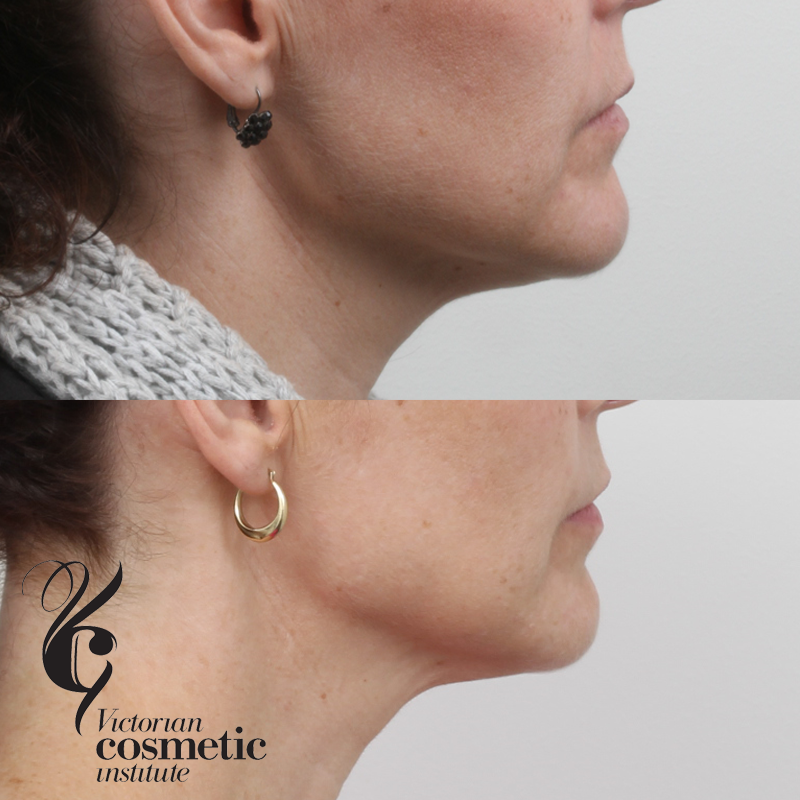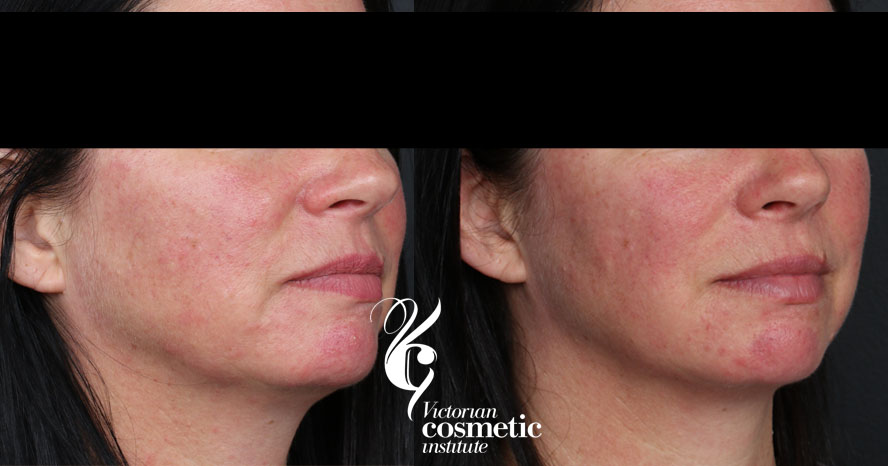This treatment is no longer performed at Victorian Cosmetic Institute. Below for information purposes only.
What is Ultherapy?
Ulthera is a device that uses focused ultrasound energy to lift and tighten the skin. Ultherapy, a blend of the words ‘Ulthera’ and ‘therapy’ describes the treatment performed with the Ulthera device. It is a safe non-surgical method to lift and tighten skin without any visible downtime.
The Ultherapy procedure is a non-invasive treatment that can be performed on the face, neck and chest. The Ulthera device uses radiofrequency ultrasound energy waves to penetrate the muscle layer of the dermis and lift the skin on the face.
It is an effective skin tightening treatment that usually only requires one 30 to 60 minute procedure to provide results. It doesn’t require any incisions and usually won’t need any recovery time.
How does it work?
Medically, ultrasound is used for a variety of reasons. The term ‘ultrasound’ is commonly associated with pregnancy scans. In these ultrasound scans, high-frequency sound waves are emitted by a hand piece, and the reflections of these sound waves are recaptured to form an image.
Conversely, Ultherapy focuses ultrasound waves to a specific point deep within the skin or beneath the skin. The Ulthera system is able to display the skin’s individual layers on a screen so that the ultrasound waves can be accurately focussed. At this point, they produce thermal energy that consequently stimulates new collagen formation and results in the tightening or lifting of the skin.
Ultherapy targets the foundational layers of the skin, including the deep dermis and the SMAS layer (or superficial muscular aponeurotic system, the layer that is tightened in face-lifts). This ‘deep heating’ leads to tightening of the skin.
There is no visible downtime to Ultherapy treatment as the superficial layers of the skin are bypassed. All of the effects are deep within the skin or beneath the surface.
The results of Ultherapy will start to become visible around 2-3 months after treatment and will continue to develop up to 6 months after treatment.
What can be treated?
Utilising the power of focused ultrasound, Ulthera skin tightening can be used to lift and tighten all areas of the face, neck and chest, including:
- The jawline
- The lower face
- The area under and around the eyes
- The forehead and brow area
- Lines around the upper lip and chin
- Wrinkles on the decolletage
It is not a replacement for a surgical face-lift. Instead, it provides an alternative for those who are looking for a non-invasive treatment to tighten skin and slow the facial ageing process.
What are the benefits of Ultherapy?
There are a number of convenient benefits that make Ultherapy an appealing option for skin tightening and rejuvenation, including:
- Safety – Ultherapy has been proven to be safe through clinical trials.
- Minimally invasive – No incisions are required because ultrasound energy is the main form of treatment.
- No recovery time and limited side effects – Patients can return to normal activity immediately.
- Natural and long-lasting – Because Ultherapy targets tissue deep within the skin, it has a lasting restorative effect that stimulates natural collagen production in the skin.
As a result of Ultherapy, your skin will appear smoother and tighter; particularly around your eyes and eyebrows. Your cheeks will appear more lifted and any folds around your nose and mouth may be reduced. You may notice an improvement in the texture of your skin as well as the level of firmness. Ultherapy may also help to even out your skin tone and improve the radiance of your skin.
How does Ultherapy work?
The Ultherapy procedure stimulates collagen production by delivering focused ultrasound energy to the skin’s foundation layer, typically addressed in cosmetic surgery, without cutting or disrupting the surface of the skin.
This process results in thermal coagulation points (TCPs). Thermal coagulation occurs when heat is generated at the site of the collagen, heating to temperatures of 60 – 70 degrees celsius. Intense vibrations are caused at a cellular level and the friction of this leads to heat formation at the localised site. During an Ulthera treatment there are approximately 1600 thermal coagulation points precisely placed into well-defined areas and depths of the skin.
How does heat make my skin tighter?
As we age our collagen begins to lose its shape, and the foundations on which our skin is supported becomes uneven and lax. This allows for the skin to sag and wrinkles begin to form. When collagen is heated, between 60 and 70 Degrees Celsius, multiple processes occur to the collagen fibers resulting in tighter and more lifted skin:
- The heat disrupts and breaks the bonds holding the collagen fibers in their shape. This allows the collagen fibers to contract, returning it to its original tight shape.
- New collagen is formed and the body registers the TCPs as an injury site which initiates the natural healing response. This response involves tissue repair and the creation of new collagen.
- Reorganisation and cross-linking of new and existing collagen also occurs at the TCP sites, giving the skin increased elasticity properties and greater resistance to physical stress to the skin.
- Inflammation from the ultrasound heat triggers a secondary natural response: The release of a specialty cell that comes along to “mop up” any damaged tissue. This is followed by fibroblasts that are responsible for creating new collagen, and replacing anything that is mopped up with new, tighter collagen.
The Ultrasound energy is delivered between 1.5mm and 4.5mm into the skin’s dermis, ensuring tightening through the deepest layers of the skin to provide long lasting results. Ultrasound imaging guides the practitioner throughout the procedure over the sections of face to be treated, allowing the different depths to be identified and correctly treated.
Unlike skin laser and surgical procedures, Ulthera bypasses the upper layers of the skin to deliver the right amount of ultrasound energy at the right depths and the right temperature.
How to prepare for Ultherapy treatment
You should stop the use of any blood thinning medications prior to your treatment because these can exacerbate bruising. You should also avoid taking any aspirin, anti-inflammatories or fish oil supplements because these could also intensify any bruising.
It may be helpful to take Arnica Montana (an oral homeopathic supplement) for 3-5 days beforehand because this may reduce swelling, but you should consult your doctor before doing so.
On the day of your appointment you should wear comfortable clothing. You may wish to take a single dose of pain relief such as paracetamol 30 minutes before the treatment. This should not worsen bruising.
What to expect when getting Ultherapy
During the treatment, a variety of ultrasound hand pieces may be used, to treat different tissue depths. The hand pieces are called transducers, and the deep tissue transducer is normally used first. The provider will use the Ulthera screen technology to locate the best point to direct the ultrasound energy.
You will feel an unpleasant sensation that feels a bit like sparks of heat, but you will be given a medical device that will allow you to direct cold air on your face at any point of discomfort. You should ask your provider to make any necessary adjustments if you experience any major discomfort.
The duration of the treatment will depend on how many areas are being treated. The practitioner will carefully mark out your face and systematically treat the desired areas. Common treatments take anywhere from 30 to 90 minutes in the clinic.
What to expect after Ultherapy
Immediately afterwards, you will be given ice packs to put on the areas of treatment to help reduce any swelling or bruising. Your face may appear pink for some time, as though you’ve had a facial. You can apply makeup straight away if you wish and you can also return to normal exercise.
Some patients may experience a toothache type of discomfort or a mild headache immediately after the procedure, but this should go away quite quickly. Bruising may occur 2-5 days after the procedure.
Some possible symptoms that can occur after the treatment include:
- Bruising, most commonly along the jawline and cheekbone.
- Tenderness to the touch, which you may notice when washing your face or applying makeup.
- Swelling or redness.
Interference with motor nerves is also possible, but uncommon. This would result in patches of numbness or weakness of facial muscles. All of these symptoms should resolve themselves within 3-4 weeks.
You shouldn’t require any time off work following the procedure.
FAQ
How much does Ultherapy cost?
The first step on your Ulthera journey is to book a consultation, your practitioner will address your concerns, assess your skin and determine if Ultherapy is right for you. The price of your treatment will be discussed in this consultation and will depend on the areas that are being treated.
Who can have Ultherapy and what areas can Ultherapy treat?
Ultherapy is most suitable for someone over the age of 35 who suffers from mild-to-moderate skin laxity. It is best for someone seeking skin tightening who does not want to have a surgical face-lift.
The results of Ultherapy cannot be compared to that of a surgical face lift, so it may not be suitable for someone seeking dramatic changes. It provides an non-invasive alternative for those looking to subtly fight the progression of skin laxity.
Ultherapy can treat all areas of the face, neck and chest, including:
- Loose cheek skin and jowls
- Sagging under the chin
- Loose skin on the neck
- The forehead and eyebrow area
How many Ultherapy treatments are needed to see results?
For most patients, only one treatment will be necessary, and future touch up treatments are recommended every year or two after the initial treatment. Some patients may need more than one initial treatment depending on how they respond to the procedure.
Is Ultherapy painful?
The ultrasound energy may provide some discomfort during the Ultherapy treatment but for most patients it is mild and very tolerable.
How long before you see results from Ultherapy?
Initial tightening of the skin can be seen immediately after treatment, much of this, however, is from the inflammation caused by the heat. True results appear over 2−3 months as the new collagen formation needs to mature. As maturation occurs collagen is realigned to provide a smooth and well supported foundation for the skin’s surface.
While Ulthera cannot duplicate the results of a facelift, it’s a clinically proven non-invasive alternative for those not ready for surgery.

